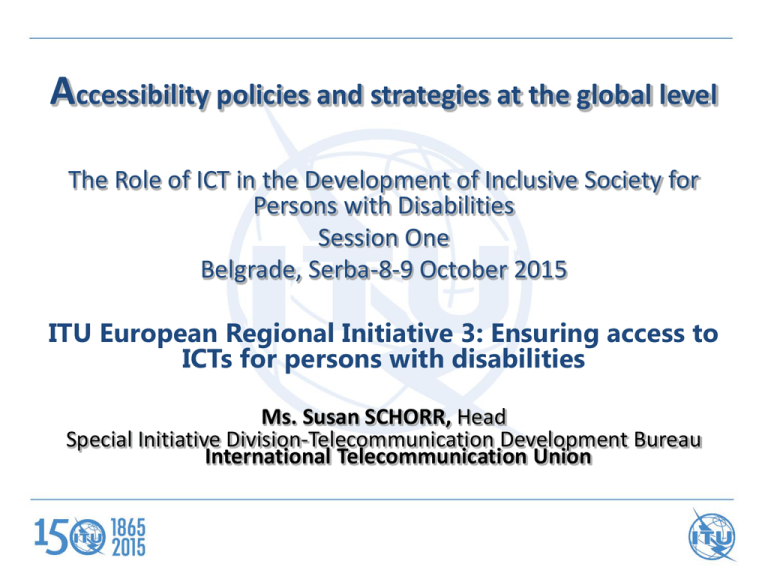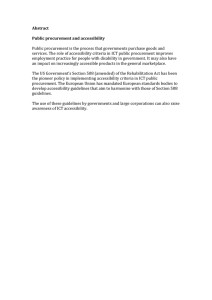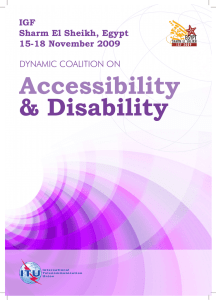A ccessibility policies and strategies at the global level
advertisement

Accessibility policies and strategies at the global level The Role of ICT in the Development of Inclusive Society for Persons with Disabilities Session One Belgrade, Serba-8-9 October 2015 ITU European Regional Initiative 3: Ensuring access to ICTs for persons with disabilities Ms. Susan SCHORR, Head Special Initiative Division-Telecommunication Development Bureau International Telecommunication Union Scope 1 billion people live with some form of disability 2012 Paralympics: Attitude Game Changer Recognizing the Capabilities of Persons with Disabilities 3 UN Convention on the Rights of Persons with Disabilities 160 signatories; 158 ratifications Source: 4 CRPD Article 9 – ICT Accessibility • To enable persons with disabilities to live independently and participate fully in all aspects of life, States Parties shall take appropriate measures to ensure to persons with disabilities access, on an equal basis with others . . . to information and communications, including information and communications technologies and systems . . . • These measures, which shall include the identification and elimination of obstacles and barriers to accessibility, shall apply to . . . Information, communications and other services, including electronic services and emergency services. 5 Accessibility means what the user requires to gain functional access to ICT If you cannot see a typical screen you need a way to understand what is on it: Screen readers Audio description Text to speech (TTS) Tactile markers Screen magnifiers Gesture-based screen readers If you cannot hear the information, you need a way to get that information: Captioning and signing Video relay services SMS and MMS Hearing aid compatibility Speech to text Volume adjustment i.e., provide alternative but equivalent ways of accessing ICTs Accessibility provides a better life for everyone Accessibility features Help: – aging populations – the illiterate Facilitate: – social inclusion – education – jobs – e-government services – emergency service 7 How to transpose ICT Accessibility provisions in the CRPD into national law? • States Parties have ICT policies, legislation and regulations • These key legal instruments must be updated to achieve the goal of promoting ICT accessibility • States Parties Disability laws also have to be updated to promote ICT accessibility • Updating States Parties Public Procurement laws may be one of the most effective ways to ensure the availability of accessible ICTs ITU-G3ICT Model ICT Accessibility Policy Report http://www.itu.int/en/ITU-D/Digital-Inclusion/Pages/Reports.aspx 9 Key elements of national ICT accessibility policies • remove barriers to ICT use by persons with different kinds of disabilities and different ICT devices and platforms (web, mobile, TV) • include persons with disabilities in policy making – create a committee on ICT accessibility • promote availability of accessible ICTs and awareness that accessible devices and services exist – train staff and reach out to organizations of persons with disabilities • use commercially available solutions • build partnerships, e.g. between academia and industry for text to speech solutions : Thank you for your attention! For more information: • www.itu.int/en/ITU-D/Digital-Inclusion/ • www.itu.int/accessibility • susan.schorr@itu.int 11

